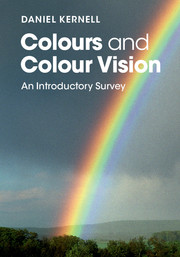Book contents
- Frontmatter
- Dedication
- Contents
- List of plates
- List of figures
- List of tables
- Preface
- 1 Colour vision in everyday life
- 2 The signals of colours: light and wavelengths
- 3 Colours and viewing conditions: not only local wavelengths
- 4 Our biological hardware: eye and brain
- 5 Eyes with unconventional properties: the ‘red-green blinds’
- 6 Other kinds of unconventional colour vision
- 7 Colour vision in different species of animals
- Appendices
- Notes
- References
- Index
- Plate section
1 - Colour vision in everyday life
Published online by Cambridge University Press: 05 March 2016
- Frontmatter
- Dedication
- Contents
- List of plates
- List of figures
- List of tables
- Preface
- 1 Colour vision in everyday life
- 2 The signals of colours: light and wavelengths
- 3 Colours and viewing conditions: not only local wavelengths
- 4 Our biological hardware: eye and brain
- 5 Eyes with unconventional properties: the ‘red-green blinds’
- 6 Other kinds of unconventional colour vision
- 7 Colour vision in different species of animals
- Appendices
- Notes
- References
- Index
- Plate section
Summary
In my childhood, the surrounding world was rather sparsely coloured. In the 1930s to 1950s, photographs and movies were typically in black and white and there were no TVs or computers and, hence, no associated colour monitors. Typewriters wrote in black (sometimes also in red), and important sections of a text were not highlighted but simply underlined with a pencil. The telephone was immobile and typically black. Books about the visual arts were largely illustrated in greyish halftones, perhaps supplemented with a small number of expensive colour plates. Since then, colours have exploded into almost all sections of modern life, at work as well as in leisure activities: colour TV, computers with colour monitors and colour printers, digital cameras with colour sensors, even telephones take colour snapshots, and magazines and newspapers are illustrated in full colour. This present-day ubiquity of colour probably does not signal a sudden change in human culture and preferences but rather it reflects the power of modern electronic and chemical technology, allowing the innate human fascination with colour to become more fully expressed.
In this introductory chapter, I write a little about the practical importance and use of colours, their names, history and cultural significance, things one might discuss without much knowledge about the colour mechanisms. For instance, how many different colours can one actually see? How can they be described and labelled?
Numbers and dimensions of colours: hue, colourfulness, brightness
Laptop manuals often mention the mind-boggling number of about 16 million colours that may be seen on the monitor screen. However, this only means that, technically, the screen can produce about 16 million different light qualities. It does not tell you how many of these qualities the human eye can distinguish from each other, seeing them as different colours; many of the 16 million colour settings will actually look the same to a human observer. Still, the total number of distinguishable colours is very large. For the analysis of this complex landscape, it is practical to consider its three main dimensions (Plate 1.1):
The hue of the colour, the property that we label with terms such as red, yellow, green, blue, etc.
The colourfulness of the colour (also often referred to as its saturation, purity or chroma), i.e. how strongly the hue is expressed. The colourfulness varies with admixtures of white/grey/black: the more white/grey/black one adds to a colour, […]
- Type
- Chapter
- Information
- Colours and Colour VisionAn Introductory Survey, pp. 1 - 35Publisher: Cambridge University PressPrint publication year: 2016
- 1
- Cited by



